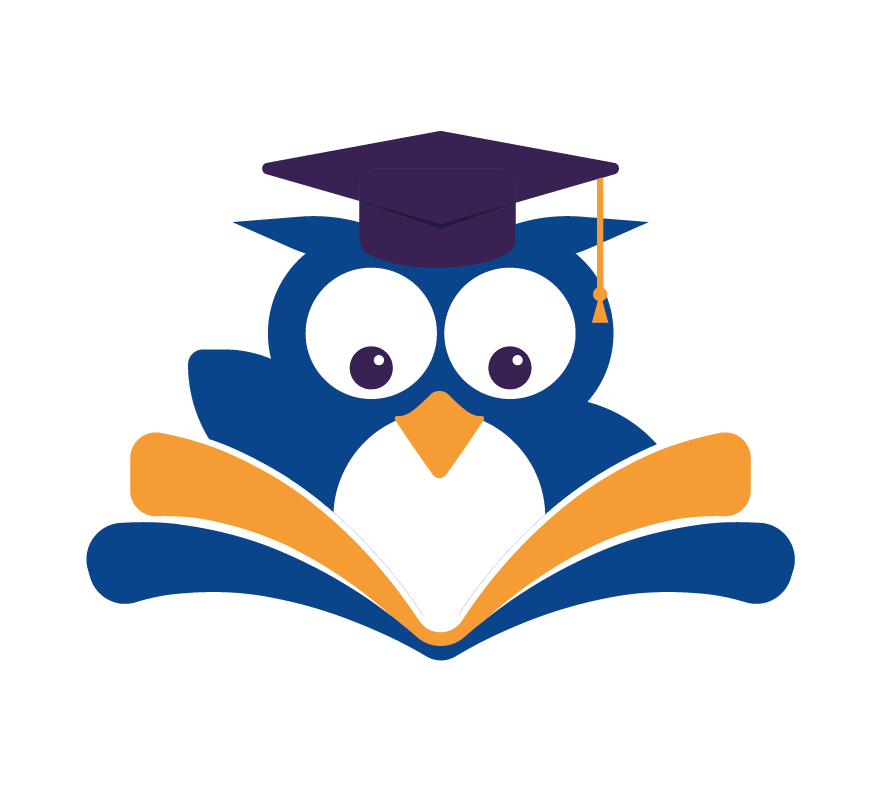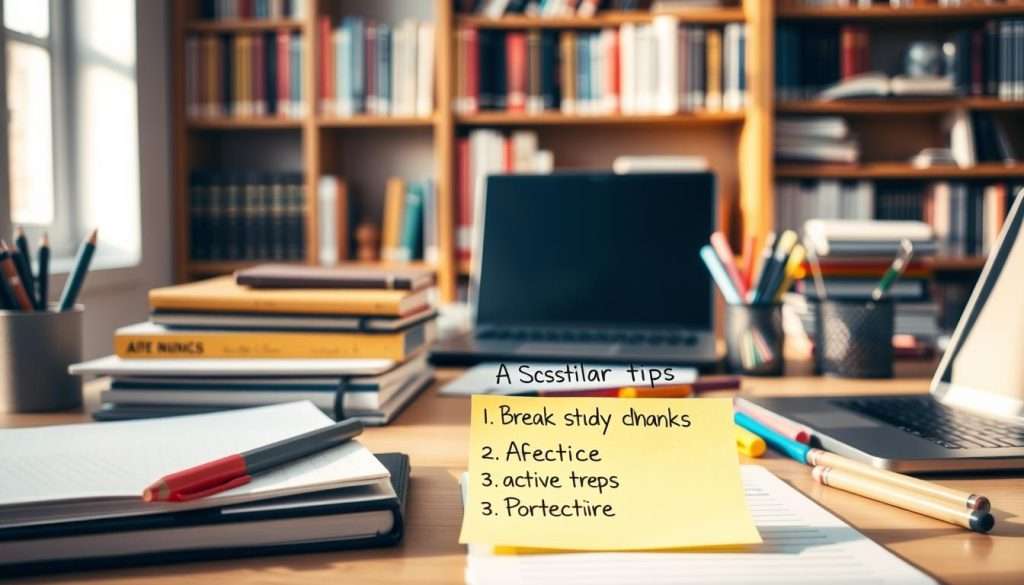Are you tired of cramming for exams and still not getting the grades you want? What if you could supercharge your learning and achieve academic success without burning out?
Learning is a lifelong journey, and how we study is key to our success and growth. To improve your learning, it’s vital to use effective learning strategies that fit your style.
By finding the best study hacks, studying can become fun and effective. We’ll look at the top study tips to help you reach your academic goals.
Key Takeaways
- Discover the most effective study techniques to boost your learning.
- Learn how to personalize your study approach for maximum retention.
- Understand the importance of adopting the right mindset for academic success.
- Explore strategies to stay motivated and focused during your study sessions.
- Find out how to make the most of your study time with simple yet powerful hacks.
Understanding the Science Behind Effective Learning
Learning effectively starts with knowing how our brains handle information. Our brains are designed to take in and process lots of data. But, how we study affects how well we remember it.
How Your Brain Processes and Retains Information
When you learn something new, it makes connections in your brain. The more you practice, the stronger these connections get. This is key for keeping information in your long-term memory. Effective learning strategies help make these connections stronger.
The Forgetting Curve and How to Combat It
Psychologist Hermann Ebbinghaus found we forget about 70% of new info in 24 hours if we don’t review it. He called this the “forgetting curve.” To fight this, review your material at spaced intervals. This way, you’re not just reading it again; you’re making it stick in your memory.
Implementing Spaced Repetition Principles
Spaced repetition is a great way to keep information in your long-term memory. Review new info soon after learning it, then wait longer between reviews. This method works well with other memorization techniques like flashcards or quizzes.
Knowing how your brain handles info and using spaced repetition can greatly improve your learning. It’s not just about studying more; it’s about studying smarter.
Setting Up Your Ideal Study Environment
Your study space greatly affects your focus and memory. A well-designed area can boost productivity and improve your studying.
Creating a Distraction-Free Zone
To make a great study space, remove distractions first. Find a quiet spot where you can study without interruptions. Using a desk or table instead of your bed helps you stay focused.
Digital Distractions and How to Eliminate Them
Digital distractions can really slow you down. Turn off your phone’s notifications, log out of social media, and use website blockers to avoid procrastination. Apps like Freedom or SelfControl can block distracting websites.
Organizing Your Study Materials
Keeping your study materials organized is key to a productive space. Have all your books, notes, and stationery within reach. Use folders, binders, or digital tools to stay organized.
The Impact of Lighting, Temperature, and Noise
The physical setup of your study area matters a lot. Make sure the room is well-lit, preferably with natural light. Keep the temperature comfortable, as extreme weather can distract you. Some like silence, while others prefer background noise. Find what works for you.
By removing distractions, organizing your stuff, and adjusting the physical setup, you can boost your productivity. This will help you reach your study goals.
Time Management Techniques for Optimal Studying
Studying can feel overwhelming, but the right time management can help. It’s not just about doing more in less time. It’s about doing the right things.
The Pomodoro Technique: Study in Focused Bursts
The Pomodoro Technique is a big help for staying focused. You work in 25-minute blocks (called “Pomodoros”) with 5-minute breaks in between. This keeps you on track and prevents burnout. After four cycles, take a 15-30 minute break to recharge.
Time Blocking: Scheduling Your Study Sessions
Time blocking means setting fixed times for studying. This avoids multitasking and distractions. It helps you focus on what’s important and use your study time wisely.
Avoiding Procrastination with Strategic Planning
Procrastination is a big study obstacle. One way to beat it is the 2-Minute Rule.
Using the 2-Minute Rule for Getting Started
If a task takes less than 2 minutes, do it right away. This rule helps start big tasks by breaking them down. It builds momentum and makes studying less scary.
Using these time management tips can help you stay focused and avoid procrastination. You’ll be on your way to reaching your academic goals.
The Best Study Hacks for Different Learning Styles
People learn in different ways. Knowing your learning style can make studying better. By figuring out if you’re a visual, auditory, kinesthetic, or reading/writing learner, you can study smarter.
Visual Learners: Mind Maps and Color Coding
Visual learners do well with mind maps and color coding. Mind maps use words, images, and colors to show your thoughts. Start with a central idea and add related topics, using colors to show main and subtopics. You can also use colors in notes to highlight important info.
For example, use red for key terms, green for definitions, and yellow for examples. This makes it easy to review and remember information.
Auditory Learners: Recording and Listening
Auditory learners learn best through sound. Recording lectures and listening later is very helpful. Try text-to-speech software or educational podcasts to learn more. Talking out loud or discussing topics helps you understand better.
“Listening is not just hearing; it’s understanding and interpreting the information to apply it effectively.”
Kinesthetic Learners: Movement and Hands-on Approaches
Kinesthetic learners do well with hands-on activities. Adding movement to your study, like using flashcards, makes learning fun. Trying different textures and materials also helps remember things.
Reading/Writing Learners: Note-Taking Strategies
Reading and writing learners need good note-taking. The Cornell and Outline Methods are great for this.
Cornell Method vs. Outline Method
| Method | Description | Benefits |
|---|---|---|
| Cornell Method | Divides the paper into two columns, with key words and questions on the left and notes on the right. | Encourages active recall and organization. |
| Outline Method | Organizes information in a hierarchical structure, using headings and subheadings. | Helps in structuring complex information and reviewing main points. |
Both methods have their benefits. Try them out to see which one works best for you.
Memory-Boosting Techniques That Actually Work
Memory-boosting techniques are not just about rote learning. They are smart strategies that make a real difference. Understanding how your brain processes information is key to memorization.
Spaced Repetition: The Key to Long-Term Retention
Spaced repetition is a top method for boosting memory. It involves reviewing material at longer intervals to solidify it in your long-term memory. This way, you’re not just memorizing; you’re making sure the information stays with you.
Mnemonic Devices and Memory Palaces
Mnemonic devices are memory aids that help you recall complex information. You can use acronyms, rhymes, or associations with familiar concepts to make memorization easier. For example, the method of loci, or a memory palace, lets you visualize a place and link information to it.
Creating Memorable Associations
The secret to mnemonic devices is creating associations that stick with you. This could be a funny image, a rhyme, or any other connection that makes the information memorable. The more vivid and unusual the association, the better it will be remembered.
Active Recall: Test Yourself to Remember
Active recall is a powerful technique that involves actively recalling information from memory. It’s better than just re-reading it. Testing yourself on the material you’re trying to learn strengthens your memory and improves retention. Flashcards are a popular tool for active recall.
| Technique | Description | Benefits |
|---|---|---|
| Spaced Repetition | Review material at increasing intervals | Long-term retention, reduces study time |
| Mnemonic Devices | Create associations to aid memory | Easier recall of complex information |
| Active Recall | Test yourself on the material | Strengthens memory, improves retention |
By using these memory-boosting techniques, you can greatly improve your ability to retain and recall information. Whether for exams or just to improve your memory, these strategies can make a big difference.
“The key to memory is not just retention, but retrieval. The more you practice recalling information, the more likely you are to remember it when it counts.”
Digital Tools and Apps to Enhance Your Study Sessions
Using digital tools and apps can really change how you study. They help you organize your study time better and stay focused. This makes studying more efficient and effective.
Note-Taking and Organization Apps
Good note-taking is key to remembering what you learn. Apps like Evernote and OneNote let you organize your notes and tag important parts. They also sync across all your devices.
These apps keep all your study materials in one spot. This makes it easier to go back and review what you’ve learned.
Flashcard and Quiz Applications
Flashcards are a classic study tool. Digital flashcard apps like Anki use a method called spaced repetition to help you remember better. Quiz apps like Quizlet let you make digital quizzes, making studying more fun and interactive.
Focus and Productivity Tools
It’s hard to stay focused while studying. Focus@Will offers music that helps you concentrate. Website blockers like Freedom and focus timers help you avoid distractions.
These tools ensure you stay on track during your study time.
Website Blockers and Focus Timers
Tools like Freedom and Cold Turkey block sites and apps that distract you. Using them with a Pomodoro Timer helps you work in focused intervals. Then, you take breaks, which boosts your productivity.

Nutrition and Physical Habits That Improve Brain Function
Your body and brain are closely linked. Let’s see how food and exercise can make your brain work better. Taking care of your body and mind is key for learning well.
Brain-Boosting Foods and Supplements
Eating foods full of omega-3s, antioxidants, and vitamins helps your brain. Add walnuts, blueberries, and fatty fish to your meals for a brain boost. Supplements like ginkgo biloba and omega-3 supplements can also help.
The Role of Exercise in Cognitive Performance
Exercise is great for your body and brain. It makes blood flow better to your brain, improving thinking and memory. Try to do at least 30 minutes of moderate exercise every day.
Sleep Optimization for Better Learning
Getting enough sleep is vital for learning and memory. Most adults need 7-9 hours of sleep each night.
The 90-Minute Sleep Cycle and Study Planning
Knowing about the 90-minute sleep cycle helps with studying. Study in focused 90-minute blocks, then take short breaks.
| Activity | Benefit |
|---|---|
| Eating brain-boosting foods | Improves cognitive function |
| Regular exercise | Enhances blood flow to the brain |
| Optimizing sleep | Aids in memory consolidation |
Group Study Strategies: When and How to Collaborate
Collaborative learning can really boost your study skills. Working with your peers can open up new insights and keep you motivated. It helps fill in any knowledge gaps you might have.
Benefits of Peer Learning and Teaching
Explaining concepts to others helps you understand them better. Peer learning brings different views and problem-solving strategies to the table. This makes studying more fun and engaging.
Structuring Effective Group Study Sessions
For the best group study, plan your sessions well. Set clear goals and assign tasks to each member. Having a regular meeting schedule keeps everyone focused and productive.
Virtual Collaboration Tools and Techniques
Today, virtual collaboration is simple. Use tools like video conferencing, shared documents, and collaborative whiteboards. These help your study group stay connected, even when you’re apart.
By using these strategies, you can maximize your group study sessions. This will help you reach your academic goals.
Overcoming Common Study Challenges and Roadblocks
The journey to academic success is not always easy. Study burnout and stress often block our way. But, knowing how to tackle these obstacles is key.
Dealing with Information Overload
In today’s world, we face a flood of information. To stay on top, focus on the most important topics first. Mind maps and flashcards can help organize what you need to know.
Managing Test Anxiety and Stress
Many students struggle with test anxiety. To fight this, try relaxation techniques like deep breathing or muscle relaxation. Exercise and a healthy diet can also lower stress.
Breathing Techniques for Instant Calm
Controlled breathing is a great way to reduce stress. Inhale for four seconds, hold for seven, and exhale for eight. This can calm your mind and body.
Recovering from Study Burnout
If you’re feeling burnt out, it’s time to take a break. Make sure you sleep well, eat right, and take breaks during study time. A short walk or some stretching can help a lot.
| Challenge | Strategy | Benefit |
|---|---|---|
| Information Overload | Prioritize study materials | Better focus on key topics |
| Test Anxiety | Relaxation techniques | Reduced stress levels |
| Study Burnout | Regular breaks and self-care | Improved mental and physical health |

Advanced Study Techniques for Complex Subjects
Complex subjects need more than just memorizing. They require advanced study techniques for deep understanding. You must use strategies that help you learn actively and remember better.
The Feynman Technique: Teaching to Learn
The Feynman Technique helps you understand complex ideas by teaching them. You simplify complex info, as if explaining it to a beginner. This method strengthens your grasp and shows where you need more work.
Concept Mapping for Complex Relationships
Concept mapping is a visual tool for organizing ideas. It helps you see how different concepts relate. By making a concept map, you can better understand how information connects, making it easier to remember and use.
Deliberate Practice: Beyond Simple Repetition
Deliberate practice is learning by challenging yourself. It’s not just about repeating what you know. It’s about learning new skills and concepts. This method is great for complex subjects, helping you understand deeply.
Breaking Down Difficult Concepts into Manageable Parts
Breaking down complex ideas into smaller parts is key. Identify the main parts and study each one well. This way, you build your understanding gradually.
Here are some strategies to try:
- Find the core concept and its main parts
- Make complex info simpler
- Use visual tools like concept maps
- Practice explaining the concept to others
Using these advanced study techniques will help you tackle complex subjects. You’ll gain a deeper understanding.
Pre-Exam Rituals and Last-Minute Study Strategies
It’s almost time for your exam. Let’s look at how to make the most of your last-minute study. Having a solid plan can boost your confidence and readiness.
The 24-Hour Exam Preparation Plan
In the last 24 hours, focus on reviewing key concepts instead of learning new stuff. Make a list of the most important topics to go over. Use active recall techniques like quizzing yourself to help remember.
Mental Preparation and Visualization
Mental prep is as key as studying. Spend time visualizing yourself doing well on the exam. Imagine feeling confident and answering questions right. This can lower anxiety and increase your confidence.
What to Do (and Not Do) the Night Before
The night before your exam is key. Don’t cram new info. Instead, focus on relaxing and recharging. Do calming things like reading or taking a warm bath. Get a good night’s sleep to be ready for the exam.
Emergency Cramming Techniques (When You Must)
If you must cram, focus on the most important topics. Use mnemonic devices to remember key info. Try to get some rest to avoid burnout.
Conclusion: Building a Personalized Study System for Ongoing Success
Now that you’ve found the best study hacks, it’s time to make a personalized study system for yourself. Try out different methods and adjust them to fit your learning style. This will help you on your path to ongoing success in school.
Study success isn’t the same for everyone. It’s about finding what works for you and sticking with it. No matter if you learn better through seeing, hearing, or doing, there’s a method out there for you.
Keep being open to new ways of studying as you go through school. With determination and the right attitude, you’ll reach your full potential and get the ongoing success you want.

